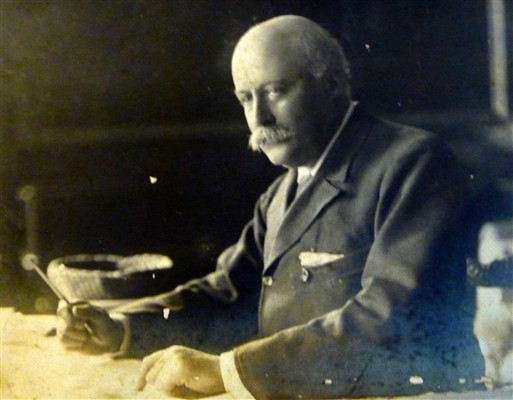Parry's Jerusalem
An inspirational anthem forged in WW1 Britain
By Jim Drury
Jerusalem isn't really a hymn. The words belong to William Blake, but they are wedded toSir Hubert Parry, Director of the Royal College of Music, most enduring composition, the choral hymn Jerusalem, which has become something like an English national song. Parry wrote it in 1916 at the request of his friend, the poet laureate Robert Bridges, as a piece that would lend itself to rousing mass singing, a tonic to wartime resolve. The first performance, at the Queen's Hall, just yards away from the future BBC Broadcasting House in London, was a rousing success.
Parry had been one of those who thought that no country would begin a modern war because the consequences would be unthinkable; he was shocked and disbelieving to find Britain at war in August 1914. Parry was a left-leaning liberal humanist, so he was not the obvious person to approach in 1916 to contribute to a choral concert for General Sir Francis Younghusband’s “Fight for Right” movement. It had been founded to raise money for anti-German propaganda and to lobby the government against seeking peace with Germany. Parry was reluctant to compose anything for such a blatantly nationalist cause. But the concert’s conductor, Henry Walford Davies, (a former pupil) and the Poet Laureate, Robert Bridges, began to work on him, suggesting he might set some little-known verses from Milton by the visionary poet and artist William Blake (1757-1827).
Parry was deeply unhappy about Fight for Right, but Bridges left him a copy of the words anyway. Davies even considered commissioning George Butterworth to set the poem if Parry declined. But after a delay Parry succumbed, giving the music to Davies with the words, “Here’s a tune for you old chap. Do what you like with it.” The setting was for unison voices with organ, and Parry was evidently quite proud of it. Davies recalled the scene in Parry’s office at the Royal College of Music, “He ceased to speak and put his finger on the note D in the second stanza where the words ‘O clouds unfold’ break his rhythm. I do not think any word passed about it, yet he made it perfectly clear that this was the one note and the one moment of the song which he treasured…”
The song was performed at the fundraising concert on 28 March 1916 in the Queen’s Hall, conducted by Walford Davies and it was an instant success. (It was called “And did those feet in ancient time” – it did not become known as “Jerusalem” until 1918. An unknown hand has crossed out Parry’s title on the orchestral score and substituted “Jerusalem’.) Parry, however, became increasingly uneasy about the cause and soon withdrew any support for Fight for Right. As he had retained personal control of the copyright, there was concern that he might withdraw the song entirely. But then a new figure entered the story. She was Millicent Garrett Fawcett, one of the leaders of the Women’s Movement, the main group fighting for women’s voting rights. It is even possible that Parry’s wife, Lady Maud, had raised the issue of the song for she was herself an active supporter of the suffragettes and a friend of Emily Pankhurst as well as of Fawcett. In any case the Women’s Movement began to take up the song enthusiastically, so that Millicent Garrett Fawcett could now ask Parry if it might officially become the Women Voters’ Hymn. Parry was delighted. He wrote to her, “Thank you for what you say about the ‘Jerusalem’ song. I wish indeed it might become the Women Voters’ Hymn as you suggest. People seem to enjoy singing it. And having the vote ought to diffuse a good deal of joy too. So they would combine happily.” He agreed to make an orchestral version to be introduced at a Suffrage Demonstration Concert on 13 March 1918, at which he conducted.
Parry died in October 1918, a victim of the influenza epidemic that hit Europe at the end of the war. In 1928, when the Women’s Movement was wound up, Parry’s executors re-assigned the copyright in Jerusalem to the Society of Women’s Institutes (a decidedly less radical organisation) where it remained until it came into the public domain in 1969. A patriotic song, then it is that rarest of beings – a left-wing patriotic song. It is in fact a protest song, written about 1804, about the rapid growth of the Industrial Revolution. The first two stanzas refer to an old legend that the boy Jesus visited the West of England with Joseph of Arimathea, in particular stopping at Glastonbury in Somerset (there had in fact been trade between the West country and Palestine for centuries – the Phoenicians certainly traded goods for English tin, lead and copper). “Did such a thing happen?” asks the poet, with the implication that it certainly could not happen now that the countryside is dominated by “dark satanic mills”. The third and fourth stanzas say that, whatever the truth of the legend, we have to put an end to growing industrialisation and strive to build a new society (“Jerusalem”) in a “green and pleasant land. On July 5th 1948, thirty years after Parry's death, many saw the foundation of the NHS as a realisation that 'Jerusaelm' had finally been built in England's 'green and pleasant land.'

Sir Hubert Parry who wrote the music for Jerusalem
commons